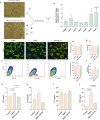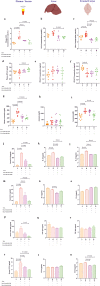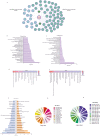Inhibition of autotaxin alleviates pathological features of hepatic encephalopathy at the level of gut-liver-brain axis: an experimental and bioinformatic study
- PMID: 37528089
- PMCID: PMC10394058
- DOI: 10.1038/s41419-023-06022-5
Inhibition of autotaxin alleviates pathological features of hepatic encephalopathy at the level of gut-liver-brain axis: an experimental and bioinformatic study
Abstract
There is accumulating evidence that the circulatory levels of autotaxin (ATX) and lysophosphatidic acid (LPA) are increased in patients with severe liver disease. However, the potential role of the ATX-LPA axis in hepatic encephalopathy (HE) remains unclear. Our study aimed to investigate the role of the ATX-LPA signaling pathway in mice with thioacetamide (TAA) induced acute HE. To show the role of the ATX-LPA axis in the context of HE, we first measured the involvement of ATX-LPA in the pathogenesis of TAA-induced acute HE. Then, we compared the potential effects of ATX inhibitor (HA130) on astrocyte responses at in vitro and gut-liver-brain axis at in vivo levels. The inflammatory chemokine (C-C motif) ligand 3 was significantly increased in the hyperammonemic condition and could be prevented by ATX inhibition in astrocytes at in vitro level. Further statistical tests revealed that plasma and tissue pro-inflammatory cytokines were inhibited by HA130 in mice. Furthermore, the stage of HE was significantly improved by HA130. The most surprising result was that HA130 alleviated immune infiltrating cells in the liver and intestine and decreased mucus-secreting cells in the intestine. Further analysis showed that the levels of liver enzymes in serum were significantly decreased in response to ATX inhibition. Surprisingly, our data indicated that HA130 could recover permeabilization of the blood-brain barrier, neuroinflammation, and recognition memory. Besides that, we found that the changes of Interleukin-1 (IL-1) and aquaporin-4 (AQP4) in HE might have a connection with the glymphatic system based on bioinformatics analyses. Taken together, our data showed that the ATX-LPA axis contributes to the pathogenesis of HE and that inhibition of ATX improves HE.
© 2023. The Author(s).
Conflict of interest statement
The authors declare no competing interests.
Figures








Similar articles
-
Inhibition of Autotaxin Ameliorates LPA-Mediated Neuroinflammation and Alleviates Neurological Dysfunction in Acute Hepatic Encephalopathy.ACS Chem Neurosci. 2022 Oct 5;13(19):2829-2841. doi: 10.1021/acschemneuro.2c00046. Epub 2022 Sep 16. ACS Chem Neurosci. 2022. PMID: 36112416
-
Autotaxin-Lysophosphatidic Acid Axis Blockade Improves Inflammation by Regulating Th17 Cell Differentiation in DSS-Induced Chronic Colitis Mice.Inflammation. 2019 Oct;42(5):1530-1541. doi: 10.1007/s10753-019-01015-z. Inflammation. 2019. PMID: 31102124
-
Dysregulation of the Lysophosphatidylcholine/Autotaxin/Lysophosphatidic Acid Axis in Acute-on-Chronic Liver Failure Is Associated With Mortality and Systemic Inflammation by Lysophosphatidic Acid-Dependent Monocyte Activation.Hepatology. 2021 Aug;74(2):907-925. doi: 10.1002/hep.31738. Epub 2021 Jun 15. Hepatology. 2021. PMID: 33908067
-
Roles of Autotaxin/Autotaxin-Lysophosphatidic Acid Axis in the Initiation and Progression of Liver Cancer.Front Oncol. 2022 Jun 13;12:922945. doi: 10.3389/fonc.2022.922945. eCollection 2022. Front Oncol. 2022. PMID: 35769713 Free PMC article. Review.
-
Autotaxin and chronic inflammatory diseases.J Autoimmun. 2019 Nov;104:102327. doi: 10.1016/j.jaut.2019.102327. Epub 2019 Aug 28. J Autoimmun. 2019. PMID: 31471142 Review.
Cited by
-
Unearthing the Potential Therapeutic Effects of Oxyresveratrol Based on Intrinsic Links between Pharmacological Effects: Implications for the Gut-Liver-Brain Axis.Pharmaceuticals (Basel). 2024 Aug 13;17(8):1063. doi: 10.3390/ph17081063. Pharmaceuticals (Basel). 2024. PMID: 39204169 Free PMC article. Review.
-
Effect of an Autotaxin Inhibitor, 2-(4-Chlorophenyl)-7-methyl-8-pentylimidazo[1,2-a] Pyrimidin-5(8H)-one (CBT-295), on Bile Duct Ligation-Induced Chronic Liver Disease and Associated Hepatic Encephalopathy in Rats.ACS Pharmacol Transl Sci. 2024 Aug 13;7(9):2662-2676. doi: 10.1021/acsptsci.4c00066. eCollection 2024 Sep 13. ACS Pharmacol Transl Sci. 2024. PMID: 39296254 Free PMC article.
References
-
- Sun X, Lv Y, Huang L, Gao H, Ren C, Li J, et al. Pro-inflammatory cytokines serve as communicating molecules between the liver and brain for hepatic encephalopathy pathogenesis and Lycium barbarum polysaccharides protection. J Ethnopharmacol. 2020;248:112357. doi: 10.1016/j.jep.2019.112357. - DOI - PubMed
-
- Trovato FM, Zia R, Artru F, Mujib S, Jerome E, Cavazza A, et al. Lysophosphatidylcholines modulate immunoregulatory checkpoints in peripheral monocytes and are associated with mortality in people with acute liver failure. J Hepatol. 2022;78:558–73. - PubMed
Publication types
MeSH terms
LinkOut - more resources
Full Text Sources
Medical
Miscellaneous

